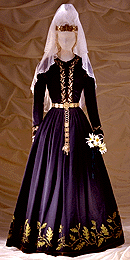
Lady's Festive Clothing
 |
Ca. 1870; Iceland; consists of seven pieces: jacket with gold metallic embroidery, skirt with embroidered oak-leaf design, veils over shaped mount, tiara and belt; CMC 69-94.1-7 Late one October evening in 1870, Anna Vilhjálmsdóttir, the daughter of a wealthy land-owner in southern Iceland, was seen leaving her father's farmstead with a bundle under her arm. She was on her way to meet her suitor, the Reverend Oddur Gíslason, who waited for her with horses some distance away. Anna took this bold step to avoid being forced into a marriage arranged by her parents to someone they considered of more acceptable status. Anna and Oddur were married with her parents' belated blessing, had fifteen children, and in 1894 emigrated to Western Canada. Local folklore had it that Anna's bundle contained this festive costume, known as a skautbúningur, traditionally used only for special occasions, such as weddings. However, Anna did not in fact wear this costume to her wedding, for it was not complete at the time of her elopement. It took two seamstresses and a silversmith more than two years to finish it and another like it for her sister. The skautbúningur is always festooned with objects of gold and silver filigree, such as the belt and tiara, and also brooches, pins and chains. In a society where almost all wealth was tied up in land, the public adornment of wives and daughters was one of the few ways a man could display his surplus wealth. |
